It looks like you're using an Ad Blocker.
Please white-list or disable AboveTopSecret.com in your ad-blocking tool.
Thank you.
Some features of ATS will be disabled while you continue to use an ad-blocker.
share:
In 1533, hundreds of dragons were reported to darken the skies over Bohemia, following a 1506 sighting of a blinding bright comet slicing over the sky. Were these foreboding occurrences signs of the apocalypse, or just a lot of Renaissance hearsay? In the 16th century a diligent scribe and artist chronicled these and other portents of woe in a book that was only rediscovered a few years ago.
The book with its 169 pages and vibrant illustrations was surprisingly intact when it went to auction in 2007 in Munich, and after it was sold to James Faber, a London-based dealer, it was revealed to be even more mysterious than previously believed, and about a century older.
hyperallergic.com...
Early conspiracy theorist
No one knows who commissioned the book’s creation, or why, but it reads like a registry of horror. In comparison to the horse-headed “Tiber monster” with scaled skin, one hoof, one bird leg, a shrieking dragon tail, a strange bazooka-like snout arm, and a human face growing out of its backside, those Bohemian dragons sporting crowns seem like happy fantasies. Meanwhile the very real destruction of Lisbon by an earthquake is accompanied by a startling whale roaring up from the waves. Elsewhere are ravenous beasts, foreboding visions in the sky, and plenty of fires. The creator often seems to be conflating reported incidents, but also trying to connect them, like an early conspiracy theorist plotting the lines to a certain impending doom.

1533 – Dragons over Bohemia” (all images from “The Book of Miracles,” courtesy Taschen)
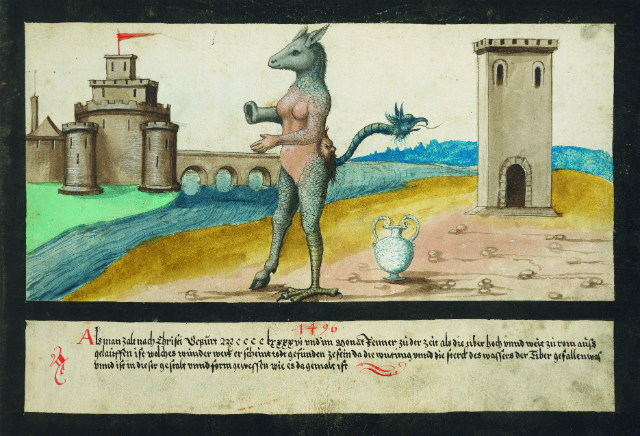
“1496 – Tiber monster”
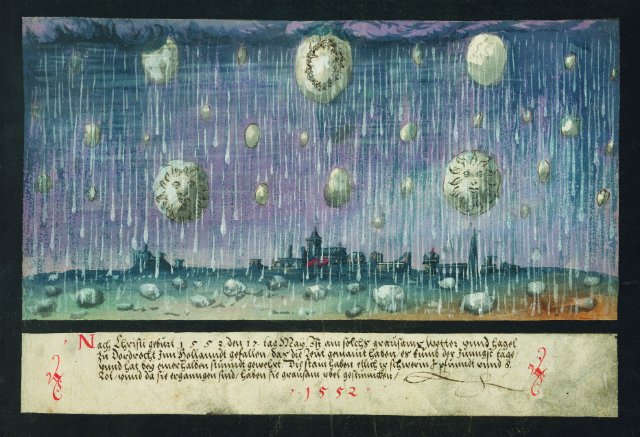
“1552 – Hail in Dordrecht”
The terrifying tale is bookended by Noah’s Ark and proceeds all the way to the apocalypse as foretold by the Book of Revelation.
www.telegraph.co.uk...
Sixteenth-century Europe was ablaze with signs and wonders. From Poland there came reports of a plague of grey and gold locusts, brought on the wind from Turkey; in Lisbon, the sky was lit up by fiery symbols, and the city was racked by a mighty earthquake; in Salzburg, the bishop’s huntsmen were said to have caught a monstrous grey creature, four-legged, with vicious claws, and the head of a woeful bearded man.
These stories travelled along the arterial trade routes of Europe, and all of them eventually reached the Free Imperial City of Augsburg, in present-day southern Germany. There, in the middle of the century, work had begun on an extraordinary volume, a wunderzeichenbuch or “book of wonders”, a compendium of prodigious happenings illustrated with vivid paintings in gouache and watercolour.
edit on
013131p://bMonday2014 by Stormdancer777 because: (no reason given)
More pictures
hyperallergic.com...
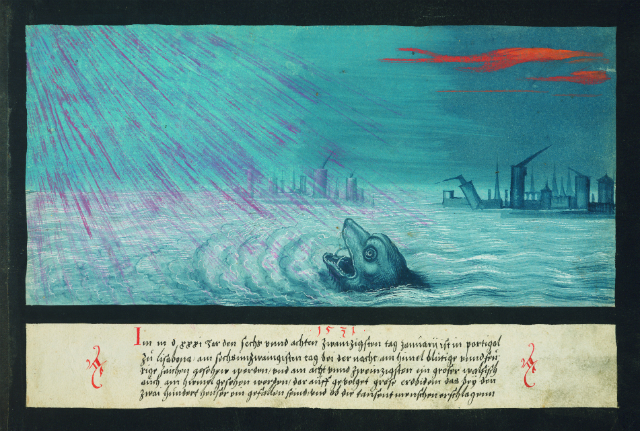
“1531 – Whale and earthquake in Lisbon”

“1506 – Comet”

“1531 – Celestial swordsman, castle and army over Strasbourg”

“73 BC – Golden balls”
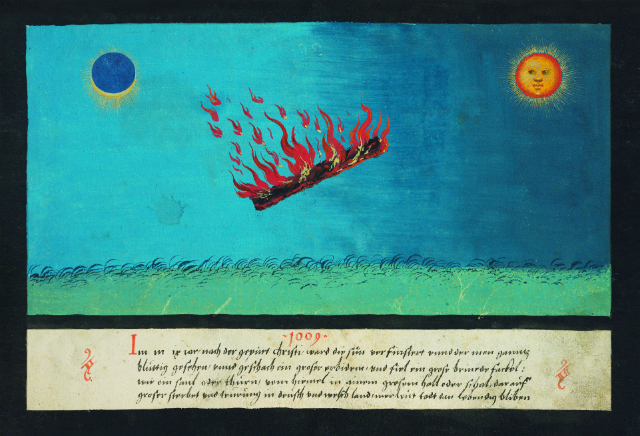
“1009 – Burning torch”
I find some of this pictures particularly interesting.
hyperallergic.com...

“1531 – Whale and earthquake in Lisbon”

“1506 – Comet”

“1531 – Celestial swordsman, castle and army over Strasbourg”

“73 BC – Golden balls”

“1009 – Burning torch”
I find some of this pictures particularly interesting.
Very interesting OP. S&F and I will be checking in on this thread often. Great thread!
R_Clark
reply to post by Stormdancer777
Great find Op! thanks
You are welcome.
Storybook Apocalypse: Beasts, Comets, and Other Signs of the End Times
www.collectorsweekly.com...
he depiction of the Tiber monster, which is said to have washed up on the banks of the Tiber river in Rome after a flood in 1496, has at least two contemporary sources. Top: “Miracles” ends with about 20 pages taken from the Book of Revelation, including chapter 13, verses 1-4.
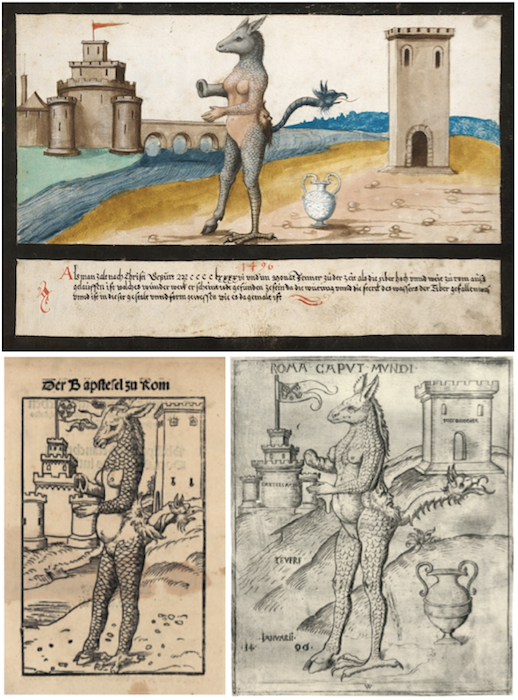
Vasa Croe
Very interesting OP. S&F and I will be checking in on this thread often. Great thread!
thanks VC
1755 Lisbon earthquake
en.wikipedia.org...
The 1755 Lisbon earthquake, also known as the Great Lisbon Earthquake, occurred in the Kingdom of Portugal on Saturday, 1 November 1755, the holiday of All Saints' Day, at around 09:40 local time.[1] In combination with subsequent fires and a tsunami, the earthquake almost totally destroyed Lisbon and adjoining areas. Seismologists today estimate the Lisbon earthquake had a magnitude in the range 8.5–9.0[2][3]) on the moment magnitude scale, with its epicentre in the Atlantic Ocean about 200 km (120 mi) west-southwest of Cape St. Vincent. Estimates place the death toll in Lisbon alone between 10,000 and 100,000 people,[4] making it one of the deadliest earthquakes in history.
on October 31, 1755, one of the largest and most splendid cities in Europe, and the next day almost completely destroyed by an earthquake, a tenth to a fifth of its population dead.

i really question the actual 'age' of the Illuminated book
much of the art-work looks like the early start of Surrealism of the 1880s90s & early 20th century modern art movement
and deliberately intended to look as if it were primitive folk art
have the colors ever been analysed to determine their components to the pre renaissance times? or has any documentation ever been done on the tome at all, to your knowledge..
other wise it is just a imaginative set up....for some reason
much of the art-work looks like the early start of Surrealism of the 1880s90s & early 20th century modern art movement
and deliberately intended to look as if it were primitive folk art
have the colors ever been analysed to determine their components to the pre renaissance times? or has any documentation ever been done on the tome at all, to your knowledge..
other wise it is just a imaginative set up....for some reason
this makes me so curious, we talk about these natural phenomenon on the forum

There was a topic resentfully about Orbs of light being precursors to earthquakes
“In the land of the Romans in the year 73 B.C., a golden ball was seen in the sky, which then came down to the Earth and rolled about and flew back up into the air again, in the direction of the rising sun, so that its great size covered up the sun completely. This was followed by the great Roman war.”

There was a topic resentfully about Orbs of light being precursors to earthquakes
Interesting and yet possible forgery. Those colors are too brilliant
reply to post by St Udio
read here
www.collectorsweekly.com...
I know about as much as you do

read here
www.collectorsweekly.com...
The presence of so much printed paper in Augsburg was also not accidental. The city was a printing center, located just a few hundred miles south of Mainz, where Johannes Gutenberg invented the printing press in the mid-15th century. Broadsheets were the Buzzfeeds of their day, featuring woodcut artwork and sensationalist headlines and text designed to capture the imagination of the common man.
The Augsburg book differs from the more common, almost scrapbook-like Books of Wonders in a number of key ways. First, it was commissioned from scratch rather than collected and amassed, although by whom we will probably never know. Second, while many of the images in “The Book of Miracles” were based on broadsheets and artwork by the likes of Hans Holbein the Younger and Albrecht Dürer, each page in the book was executed by hand, in colorful gouache and watercolor.
After much research, which includes matching watermarks on the original book’s handmade paper pages to those prevalent in Augsburg at the time, Borchert believes that the 16th-century artists who executed the original manuscript were Hans Burgkmair the Younger, Heinrich Vogtherr the Younger, and an unknown number of apprentices, a standard practice of the period. To its credit, Taschen has reproduced these plates at virtually full size (9 1/2 by 13 1/2 inches), including the backs of each piece of paper, smudge marks and all, exactly as in the original manuscript. Only two sheets of the original 160-plus images are unaccounted for.
I know about as much as you do
The “Book of Miracles” includes 26 examples of comets, including this one: “In the year 1007 A.D., a wondrous comet appeared. It gave off fire and flames in all directions. As it fell to Earth it was seen in Germany and Italy.”

reply to post by Stormdancer777
The book looks fascinating, but at $100-$150 a copy, a little out of my price range I'm afraid.
www.amazon.com...
The book looks fascinating, but at $100-$150 a copy, a little out of my price range I'm afraid.
www.amazon.com...
reply to post by Stormdancer777
Very interesting Stormdancer777.
So - this was a "Josephus-like" work... ...?
I presume the 'author' or, at least, the illustrator...had seen the former representations for the "Tiber monster". Can't believe they would call 'her' a monster, though.
Very interesting Stormdancer777.
So - this was a "Josephus-like" work... ...?
I presume the 'author' or, at least, the illustrator...had seen the former representations for the "Tiber monster". Can't believe they would call 'her' a monster, though.
reply to post by Stormdancer777
Looks a lot like the Codex Seraphinianus by Luigi Serafini.
en.m.wikipedia.org...
Looks a lot like the Codex Seraphinianus by Luigi Serafini.
en.m.wikipedia.org...
reply to post by Jordan River
www.taschen.com...
another link you can check out
I wonder what that future end of the word thingy is?

www.taschen.com...
another link you can check out
The Book of Miracles that first surfaced a few years ago and recently made its way into an American private collection is one of the most spectacular new discoveries in the field of Renaissance art. The nearly complete surviving illustrated manuscript, which was created in the Swabian Imperial Free City of Augsburg around 1550, is composed of 169 pages with large-format illustrations in gouache and watercolor depicting wondrous and often eerie celestial phenomena, constellations, conflagrations, and floods as well as other catastrophes and occurrences. It deals with events ranging from the creation of the world and incidents drawn from the Old Testament, ancient tradition, and medieval chronicles to those that took place in the immediate present of the book’s author and, with the illustrations of the visionary Book of Revelation, even includes the future end of the world.
I wonder what that future end of the word thingy is?

edit on 013131p://bMonday2014 by Stormdancer777 because: (no reason given)
MissBeck
reply to post by Stormdancer777
The book looks fascinating, but at $100-$150 a copy, a little out of my price range I'm afraid.
www.amazon.com...
me too
LiveForever8
reply to post by Stormdancer777
Looks a lot like the Codex Seraphinianus by Luigi Serafini.
en.m.wikipedia.org...
thank you
wow
edit on 013131p://bMonday2014 by Stormdancer777 because: (no reason given)
butcherguy
More descriptions and depictions of the Tiber River monster here:
The Monster of Ravenna
thanks butcherguy
WanDash
reply to post by Stormdancer777
Very interesting Stormdancer777.
So - this was a "Josephus-like" work... ...?
I presume the 'author' or, at least, the illustrator...had seen the former representations for the "Tiber monster". Can't believe they would call 'her' a monster, though.
what do you mean by her, seriously don't know ?
new topics
-
Colorado voting system passwords didn't start getting changed until after p/w leak became public
2024 Elections: 8 minutes ago -
Double Homicide.
Short Stories: 1 hours ago -
Joe Rogan Experience #2221 - JD Vance
2024 Elections: 2 hours ago -
What Happens if They Manage to Take Him Out BEFORE the Election?
2024 Elections: 2 hours ago -
From Tribes to Superpowers: The Evolution of Human Societies Toward Global Dominance
New World Order: 3 hours ago -
Election statistics question
2024 Elections: 5 hours ago -
True Voter Surpression and an attack on a voter in North Carolina
US Political Madness: 5 hours ago -
Innocent until proven guilty.
Rant: 5 hours ago -
ABC Broadcasts Election results on "Accident"
2024 Elections: 10 hours ago -
Chinese citizen charged after allegedly voting illegally in key battleground state;
2024 Elections: 11 hours ago
top topics
-
True Voter Surpression and an attack on a voter in North Carolina
US Political Madness: 5 hours ago, 12 flags -
ABC Broadcasts Election results on "Accident"
2024 Elections: 10 hours ago, 11 flags -
Redux of alien abduction account which shocked me to my core in childhood..
The Gray Area: 14 hours ago, 10 flags -
Chinese citizen charged after allegedly voting illegally in key battleground state;
2024 Elections: 11 hours ago, 9 flags -
What Happens if They Manage to Take Him Out BEFORE the Election?
2024 Elections: 2 hours ago, 9 flags -
Bonkers Biden Bites Babies!
Politicians & People: 12 hours ago, 8 flags -
Soldiers Encountered...Something
Cryptozoology: 13 hours ago, 7 flags -
The Manhattan Alien Abduction
Aliens and UFOs: 12 hours ago, 5 flags -
Joe Rogan Experience #2221 - JD Vance
2024 Elections: 2 hours ago, 4 flags -
Double Homicide.
Short Stories: 1 hours ago, 3 flags
active topics
-
True Voter Surpression and an attack on a voter in North Carolina
US Political Madness • 33 • : RazorV66 -
Steal the vote alive and well
2024 Elections • 21 • : WeMustCare -
Colorado voting system passwords didn't start getting changed until after p/w leak became public
2024 Elections • 0 • : xuenchen -
Betting markets have Trump by a good bit
2024 Elections • 79 • : UKTruth -
Double Homicide.
Short Stories • 1 • : FullHeathen -
What Happens if They Manage to Take Him Out BEFORE the Election?
2024 Elections • 14 • : matafuchs -
Far-Left Author Bob Woodward to Drop ‘October Surprise’ on Kamala Harris and Joe Biden
US Political Madness • 38 • : DontTreadOnMe -
Democrat Leaders Say Trump Supporters are DEPLORABLE - DREGS - GARBAGE. Which Label is The Worse?.
US Political Madness • 20 • : WeMustCare -
The Acronym Game .. Pt.4
General Chit Chat • 867 • : JJproductions -
Innocent until proven guilty.
Rant • 4 • : Shoshanna
